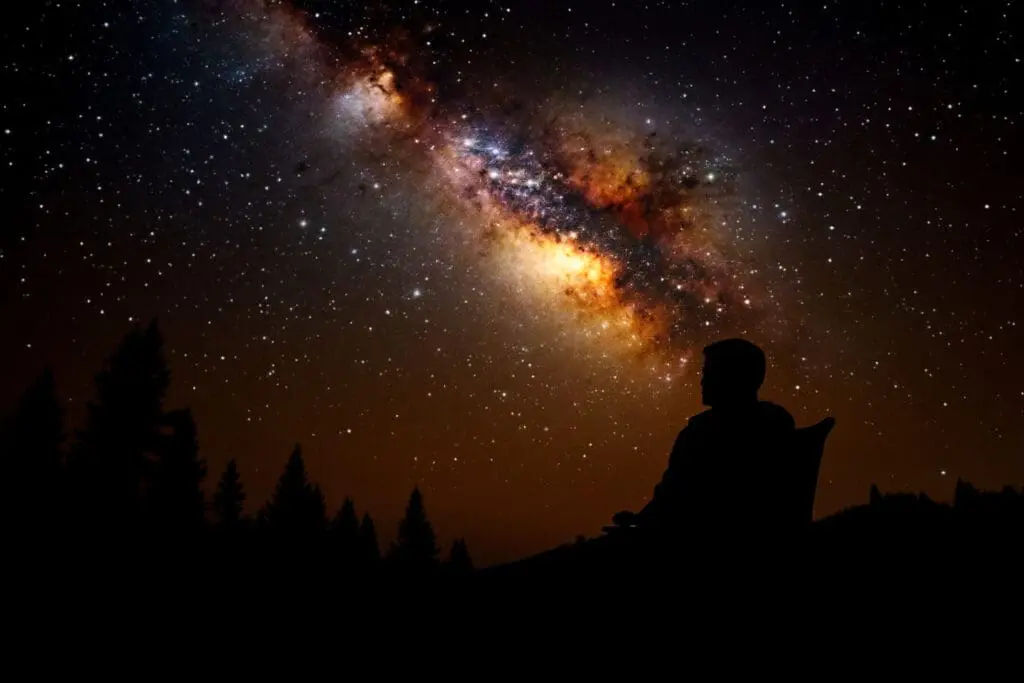There’s a specific feeling that comes from staring up into a truly dark night sky. It’s a mix of awe and a strange sense of connection to something impossibly old and enormous. If you’ve felt it, you know it’s the spark for something more. It’s what makes you want to connect the dots, learn the names, and really see what’s up there. But that’s usually where the big question hits: how to start stargazing? It feels like you need a science degree and a mountain-top observatory, but that couldn’t be further from the truth. You don’t need a fortune.
You just need curiosity. This guide is your starting line. We’ll go through everything you need—and everything you don’t—to start making sense of the sky over your head. Forget the complicated charts and dense terminology for now. At its core, stargazing is just about looking up. Let’s figure out how to do it.
More in The Big Picture Category
How Astrophysics Explains Stars
Key Takeaways
- Start with just your eyes. Seriously. A telescope can wait. Learning the sky with your own eyes first is the best way to build a solid foundation.
- Darkness is your number one priority. Getting away from city lights will make a bigger difference than any piece of equipment.
- Find the main road signs. The sky has its own landmarks, like the North Star. Learning a few key constellations is like learning the major highways.
- Let your phone be your guide. Modern apps are like having an astronomer in your pocket. Use them.
- Give your eyes a chance. It takes a good 20 minutes for your vision to fully adapt to the dark. Be patient; the view is worth it.
So, You Want to See the Stars? Where Do You Even Begin?
It really just begins with the decision to step outside on a clear night, leave the screens behind, and look up. That’s the whole first step. The cost of admission to this hobby is practically zero. The universe puts on a stunning show every single night, free of charge. All you have to do is pay attention.
The biggest mistake people make right out of the gate is assuming they need to buy a lot of expensive equipment. That path usually ends with a complicated piece of gear gathering dust and a hobby that dies before it gets going. The right way to start is with the best optical instruments you already own: your eyes. They’re more than enough to appreciate the immense scale of the cosmos. Your first mission isn’t to track down a faint galaxy; it’s to get to know the sky.
Do I Really Need a Telescope Right Away?
Nope. And I would strongly recommend against buying one just yet. A telescope is a fantastic tool, but using one without knowing the sky is like trying to find a specific person in a massive city using only a mailing tube to look through. Telescopes give you a tiny, magnified window. If you have no idea where to aim that window, you’ll spend the whole night staring at blank, black patches of space, getting cold and annoyed.
By starting without one, you force yourself to learn the basics. You’ll learn how to spot the brightest stars and pick out the major constellations. You’ll get a feel for how the sky appears to turn during the night and shift through the seasons. That’s the knowledge that turns a telescope from a frustrating puzzle into a powerful key for unlocking the universe’s secrets.
What’s the Most Important Thing I Need to Start?
Above all else: a dark sky. This is the one thing you can’t compromise on. You could have a billion-dollar telescope, but if you’re in the middle of a city, you won’t see much more than the Moon and a handful of planets. The artificial glow from our cities creates a dome of light pollution that effectively blots out the faint light from stars and galaxies.
Finding a dark place is your first real mission. That means getting away from the lights. Even a twenty-minute drive out of town can have a jaw-dropping effect. A sky that looked nearly empty from your backyard can suddenly reveal thousands of stars. You might even see the Milky Way arching overhead like a soft, glowing cloud—a sight that changes you a little bit. The search for true darkness is the one thing that unites every amateur astronomer.
Finding Your Perfect Stargazing Spot
Understanding you need dark skies is one thing, but how do you actually find them? It can seem tough if you live in a big city or suburb. The light dome from a metropolis can be seen from almost an hour’s drive away. Still, with a bit of prep, you can find your own portal to the cosmos.
You’re looking for a spot with a big, open view, especially away from the glare of any nearby streetlights or buildings. This could be a state park, a remote backroad with a safe spot to park, or even a friend’s property in the country. Just make sure you’re safe and that you’re allowed to be there after dark. Going with a friend is always a good idea.
How Can I Find a Truly Dark Place to Stargaze?
Thankfully, we have some amazing tools for this hunt. Online light pollution maps are your best friend. A great place to start is the website for the International Dark-Sky Association. They provide tons of information and even certify “Dark Sky Parks,” which are areas specifically protected for their incredible night skies. Making a trip to one is an unforgettable experience.
For finding spots closer to home, just search for a light pollution map online. These maps use satellite data to show you exactly where the city glow is the worst. You want to head for the areas marked blue, gray, or black. You might be surprised that a pretty good spot is just a short drive away.
What Else Makes a Good Observation Site?
Darkness is king, but a few other things help. A clear view of the horizon is a huge plus, so try to avoid places surrounded by tall trees or hills. Speaking of hills, getting to a higher elevation can lift you above some of the ground-level haze and light domes, giving you a clearer view.
Finally, think about the practical stuff. Is it easy to get to? Is parking safe? Are you going to be blasted by headlights from passing traffic? Checking out a potential spot during the day can save you a lot of trouble later. When you find a reliable, comfortable spot, you’ll be much more likely to make stargazing a regular part of your life.
Learning the Sky: Your Celestial Roadmap
So you did it. You’re out in the dark, under a sky flooded with stars. It’s awesome, but it can also be a bit disorienting. It’s just a jumble of dots. How do you start to make sense of it all? This is where the real fun begins. You’re about to learn how to read the oldest map there is.
The trick is to not get overwhelmed. You’d never try to memorize a world atlas in one night. You’d start with the continents. For the night sky, our “continents” are the constellations. These are the star patterns that humans have been using for millennia to navigate, tell time, and tell stories. Learning to spot just a few of the big ones will change the sky from a chaotic mess into a familiar map.
How Do I Stop Feeling So Lost When I Look Up?
You need a landmark. In the Northern Hemisphere, your primary landmark is Polaris, the North Star. Polaris is important not because it’s super bright—it’s not—but because its position in the sky is almost directly over the Earth’s North Pole. As the Earth spins, every other star wheels across the sky in a slow arc. Polaris stays put.
Find Polaris, and you instantly know which way is north. It’s your compass. The easiest way to find it is to first find the most famous pattern in the sky: the Big Dipper.
- First, find the Big Dipper. It’s big, bright, and looks like a soup ladle.
- Look at the two stars that form the front edge of the Dipper’s “bowl.” These are often called the “pointer stars.”
- Imagine a line connecting these two stars, and then extend that line out of the top of the bowl.
- Keep going along that line, and the very first moderately bright star you hit is Polaris.
That’s it. You just used the stars themselves to navigate. Once you can do that reliably, the sky starts to feel like a place you know.
Are There Any Easy “Signposts” in the Night Sky?
You bet. The sky is full of them. After you’ve mastered the Big Dipper, you can move on to other seasonal heavy-hitters. In the winter, you can’t miss Orion the Hunter, with his unmistakable three-star belt. During the summer, the “Summer Triangle”—made of three brilliant stars named Vega, Deneb, and Altair—dominates the overhead view.
The best way to learn these is with a little help. A few tools are perfect for beginners:
- A Planisphere (Star Wheel): This is a brilliant piece of low-tech gear. You just spin a wheel to your current date and time, and it shows you a map of what’s up. It’s great because it won’t wreck your night vision with a bright screen.
- Star Charts: A good beginner’s astronomy book or website will have charts for each season. You can print them out and bring them with you.
- Smartphone Apps: This is where modern tech makes things so much easier. Apps like Stellarium, SkyView, or Star Walk use your phone’s location and sensors to show you exactly what you’re pointing at in real-time. They are, hands down, the most powerful learning tool a beginner can have.
Gearing Up: When You’re Ready for More
After a few months of getting to know your way around the constellations, you might get that itch to see a little more. You want to see things in a bit more detail. Now is the time to think about your first piece of gear. And it’s still not a telescope.
Your first and best investment is a good pair of binoculars. They are the perfect next step, giving you a huge boost in what you can see without the steep learning curve of a telescope. They’re easy to use, easy to carry, and won’t break the bank.
What’s the Best First “Upgrade” from My Eyes?
Binoculars will completely change your view of the heavens. Stars you couldn’t see before will pop into view. The faint, milky smear of our galaxy will resolve into fields of countless tiny stars. They’re strong enough to let you spot the four biggest moons orbiting Jupiter, see the crescent shape of Venus, and explore the rugged craters on our own Moon in stunning detail.
For stargazing, look for binoculars with numbers like 7×50 or 10×50. The first number is the magnification (how much closer things look), and the second is the size of the main lenses in millimeters. That second number is key—bigger lenses gather more light, which is what astronomy is all about. A 7×50 or 10×50 pair is a fantastic starting point. They gather lots of light but aren’t so heavy that they’re impossible to hold steady.
Okay, I’m Ready for a Telescope. What Should I Look For?
The time has finally come. You know the constellations, you’ve scanned the skies with binoculars, and you’re ready to take the leap. The world of telescopes is exciting, but it’s also full of confusing terms. Let’s cut through the noise.
The single most important thing about any telescope is its aperture. That’s the diameter of its main mirror or lens. Aperture is everything because it determines how much light the telescope can collect. More light means you can see fainter things. A telescope with a 6-inch mirror will always outperform a telescope with a 3-inch lens, no matter what the box says about “600x magnification.” That’s just a marketing trap. Insanely high magnification on a small telescope just gives you a dim, wobbly, blurry image.
For most beginners, the best bang for your buck is a type of telescope called a Dobsonian. This is a simple but powerful design: a reflector telescope (using a mirror) on a lazy-susan-style mount. You just plop it on the ground, and you’re ready to go. They offer the biggest aperture for the lowest price. A 6-inch or 8-inch Dobsonian is a beast. It will give you breathtaking views of Saturn’s rings, Jupiter’s cloud bands, sparkling star clusters, glowing nebulae, and even the faint smudges of other galaxies.
What Can You Actually See Up There?
The universe is packed with amazing things to see, and many of them are within reach of a total beginner. Every step you take, from your eyes to binoculars to a telescope, opens up a whole new catalog of cosmic sights.
The easiest things to spot are our neighbors in the solar system. They’re bright, they move against the starfield from one night to the next, and they show amazing detail.
- The Moon: Never, ever dismiss the Moon. It is the most rewarding object to look at through any telescope, big or small. The best time to observe isn’t when it’s full and bright, but during its other phases. Look along the terminator—the line where light meets dark—and the long shadows will reveal a breathtaking world of mountains and craters.
- The Planets: You can see five planets without any equipment at all: Mercury, Venus, Mars, Jupiter, and Saturn. They look like very bright stars that don’t twinkle. Through binoculars, you can spot Jupiter’s moons. With a small telescope, the view of Saturn’s rings will be something you remember for the rest of your life.
Outside our solar system, there’s a whole universe of “deep-sky objects.” Binoculars are fantastic for sweeping through the Milky Way and bumping into beautiful star clusters. A telescope will take you to the next level, letting you see the ghostly glow of nebulae where new stars are being born, like the famous Orion Nebula. And from a dark spot, even a modest telescope can show you the faint oval of the Andromeda Galaxy. You’ll be seeing light from a trillion stars that has been traveling through space for two and a half million years, just to end its journey in your eye.
It’s a perspective-shifting experience. And you will never get tired of it.
FAQ – How to Start Stargazing

Do I need a telescope right away to enjoy stargazing?
No, a telescope is not necessary when starting out. Your own eyes are the best and most fundamental tools for learning the sky. A telescope can enhance your observations later, once you understand the basic patterns and identify celestial objects of interest. Starting with your eyes and perhaps binoculars allows you to learn the sky without the frustration of aiming equipment without knowledge.
What is the best way for beginners to learn the constellations and navigate the night sky?
Beginners should start with prominent celestial landmarks like Polaris, the North Star, and well-known constellations such as the Big Dipper. Using simple tools like a planisphere or star charts, along with smartphone apps like Stellarium or Star Walk, can help you identify constellations and learn their positions. These tools make it easier to connect the dots and turn the sky into a familiar map.
Why is finding a dark sky crucial for stargazing, and how can I locate one?
Dark skies are essential because artificial light from cities creates a glow that obscures stars and faint celestial objects. To find a dark sky, use online light pollution maps or websites like the International Dark-Sky Association to identify nearby dark sky parks or low-light areas. Heading to places marked with low light pollution, such as rural locations, parks, or remote backroads, enhances visibility and the overall experience.
How can I start stargazing without any prior experience or equipment?
You can begin by simply going outside on a clear night and looking up at the sky with your own eyes. Learning to recognize the brightest stars and key constellations is the best initial step, and this can be done without any equipment. Using free or low-cost tools like light pollution maps, star charts, or smartphone apps can help you identify the best viewing spots and guide you in learning the night sky.

